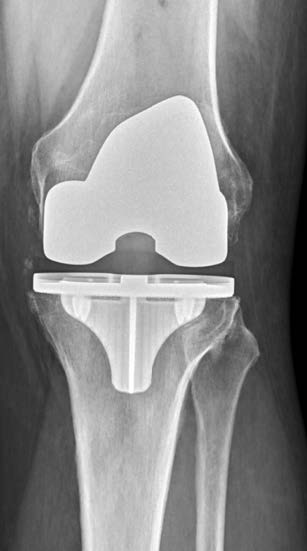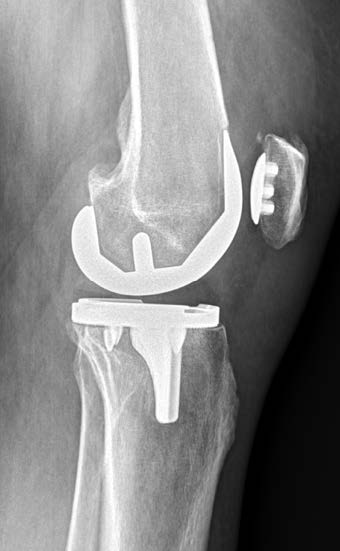Revision Knee Replacement
EspañolWhat is a Revision Knee Replacement?
Knee replacement surgeries are very successful at relieving pain, restoring mobility, and improving function for patients with knee arthritis. Currently, over 500,000 total knee replacements are performed in the United States each year. Now that our older population is living well into their 70s and 80s, it has been projected that over 1.3 million knee replacements will be performed in 2030!
Despite great results, there are times when a knee replacement procedure needs to be re-done (revised) because just like your car, certain parts can wear and/or fail over time. Patients may complain of increasing pain and swelling in addition to stiffness and catching. These signs may represent a problem with your knee replacement, and you should talk with your surgeon regarding these issues and concerns. There are several common reasons for revision surgery that we will cover in this article.
Print Friendly
Print a copy of this article.



Why would I Need a Revision Surgery?
According to the American Joint Replacement Registry (AJRR) in 2019 about 12,000 knee revision knee surgeries were performed for one of the following reasons: 1) Infection, 2) Loosening, 3) Instability, 4) Polyethylene Wear, 5) Fracture/Broken Bone.
Infection is the most common cause of having to undergo a revision knee replacement. Infections may develop right after surgery or years later if the infection travels from another part of the body. An infected knee replacement is a BIG DEAL. Surgery is usually necessary to help your body fight the infection. Bacteria like to stick to metal implants and can be hard to remove, which is why surgery is typically necessary to treat an infection. There are a few basic options to treat infection—a washout versus implant removal—described below.
- If the infection is caught early (within 4-6 weeks of surgery/symptoms) a “washout” procedure can be performed where the knee joint is opened in the operating room and thoroughly washed along with exchange of the plastic spacer (liner). This is usually followed by intravenous antibiotics for about 6 weeks and oral antibiotics after this for an extended amount of time (depending on the situation can be 3 months to lifelong antibiotic use).
- If the infection is found later (usually beyond 4 weeks) your ability to clear the infection becomes more difficult. All the knee components may need to be removed for a short period of time to give you a better chance to clear the infection. In this setting, a temporary implant is used, made of or coated with antibiotic cement. It is inserted for several weeks followed by intravenous antibiotics until another new implant can be inserted (also known as a two-stage exchange procedure). Alternatively, the implants can be removed and all reinserted in the same surgery, called a 1-stage procedure.
Loosening is the second most common reason for another knee surgery. Over time the components can wear down, break, and/or become loose from their attachments to the surrounding bone. Patients may complain of repeated swelling of the knee and/or pain when first standing up to use the knee joint (“start-up” pain).

An unstable knee replacement (instability) can lead to pain and affect your balance and function. The knee replacement can feel unstable, shift, or give way when walking on uneven ground or stairs. The alignment of the original knee components can change over time, or the soft tissues around the knee may stretch out leading to feelings of instability. There is a spectrum of instability of the knee from very subtle feelings of the knee being unstable to a complete dislocation. The extent of the instability will factor into what needs to be done during revision surgery.

Wearing of the plastic liner (polyethylene wear) represents another source of failure. There is a plastic spacer situated between the end of the thighbone and top of the shin bone in a knee replacement (see picture below). This spacer can wear down over time leading to knee joint instability and sometimes loosening of the prosthesis. Thankfully, newer designs make the plastic liner more wear resistant and we hope to see today’s knee replacements last longer.
A fracture (break) in the bone around the knee replacement from a fall or other trauma can cause the knee implants to become loose. Some of the implants may need to be replaced or repaired to make the bone more stable. Alternatively, the knee implants may be stable and only the bone may need to be fixed so it heals appropriately.

Differences from a First (Primary) Surgery:
- Compared to an initial surgery these revision procedures often take longer, have higher risks, and may require restrictions during your early recovery after surgery.
- It is important to remember that a second surgery may require removing all of the original implants, preparation of the bone and then placement of the new implants. Therefore, the surgery is likely to take longer to safely accomplish these tasks.
- With each passing surgery the risk for infection and other complications will increase and appropriate measures will be taken to minimize these risks. It is important to follow your surgeon’s protocols and instructions very closely to help avoid any problems.
- Depending on the extent of your surgery and implants used, you may have restrictions in weight bearing, range of motion, and exercises after surgery.
What Does Revision Surgery Entail? How Is It Different than my First Surgery?
A revision knee replacement is a more difficult procedure compared to your original surgery. Therefore, this type of procedure should be performed by an orthopedic surgeon experienced in revision surgery. Some patients require a PARTIAL REVISION where just one or two of the components (femur, tibia, liner, or kneecap) are replaced while other patients need a FULL REVISION where all the components are exchanged. Revision surgery may require your surgeon to use special implants. Some other potential differences from your first surgery include:
- A larger incision is generally required to access the old implants and make room for the new implants. Scar tissue can make this part of the surgery more challenging because it takes more time to carefully remove it. Next, if a component is well-fixed to the bone, it must be carefully freed from the bone. The goal is to remove the component without damaging the underlying supporting bone. If the component was cemented in place, the remaining cement will need to be removed as well. Specialized instruments are available for these tasks allowing surgeons to remove implants in a timely and safe manner.
- The surgeon determines which revision implants are needed to address the problem after assessing the remaining bone and soft tissues. Revision implants are usually larger than original knee components to help ensure the new components are well anchored to the surrounding bone (see pictures on next page). The new implants are then usually cemented into place. A new plastic spacer is used to fine tune the stability of the knee revision. The implants will often include stems (rods) that go up and down the thigh and shin bones to help anchor your implant in place. The stems are akin to footings that are used to support a house that is built on unstable ground and will support the implants to keep them fixed to your bone.
Think of a knee revision like getting new car tires. The new tires (components) are installed, and the surgeon must make sure the new pieces are balanced and aligned for good function afterwards.

What type of outcomes should I expect from a revision knee procedure?
Generally, revision surgeries are more complex; therefore, healing may take longer compared to your original knee replacement. The length of recovery from a revision knee replacement depends on your medical issues, the extent of the revision surgery, and your physical therapy afterwards.
Usually, the typical recovery from a revision knee procedure takes about 3-4 months. However, some studies have shown it can be between 1-2 years before fully recovering from your knee revision surgery. Most of the time, your surgeon will allow you to weight bear on your operative leg almost immediately after surgery with
a walker or crutches. In some cases, your surgeon will ask you to limit how much weight you place on your operated leg for a period of time to allow the bone and soft tissues to recover. Remember it is normal for swelling to come and go during the recovery process.
Because revision knee replacement takes longer than your original knee replacement, there is a higher risk for complications during/after revision surgery. The most common risks and complications include:
- Infection – in primary knee replacements the national average of infection is between 1-2%. The risk of infection after a revision knee replacement can be as high as 12%. This increased risk is because of a longer surgery time and bigger incision necessary to complete the revision surgery.
- Fracture – sometimes there is difficulty removing the old components from the surrounding bone or the patient has poor bone quality both of which make fracture a possibility during surgery. If a fracture does occur, your revision surgeon will know how to address it during surgery.
- Blood clots – since revision surgery takes longer and your recovery can be slower patients have an increased risk for developing a blood clot after surgery. Just like your original knee replacement surgery a blood thinner will be required to lower the risk of blood clots after revision surgery. Simple things like ankle pumps and getting in and out of bed can help reduce your risks for a blood clot after surgery.
- Nerve and vascular injury – Some of the nerves and vessels around the knee can be located in a slightly different position at the time of revision surgery. Therefore, your surgeon must work carefully to find and protect these important structures.
- Stiffness – since a larger incision is necessary more scar tissue can form after a revision knee replacement. Working diligently with your surgeon and therapist can help ensure you avoid excessive stiffness afterwards.
Conclusion
Most knee replacements will function well between 15-20 years; however, over time your knee replacement may require a revision surgery to keep you mobile and functional. There are several reasons for revision surgery including infection, loosening, instability, wear, and fracture. Remember that revision surgeries are longer and more complex compared to your original surgery. As a patient, you need to feel comfortable with your surgeon. Revision surgery can be complicated therefore it is important that you have a good understanding for why a revision surgery is necessary. Do not hesitate to ask questions. Your surgeon can further explain the risks, benefits, and expected recovery time for your revision procedure.
This article has been written by Matthew W. Bullock, DO in collaboration with the AAHKS Patient and Public Relations Committee and peer reviewed by the AAHKS Evidence Based Medicine Committee. Links to these pages or content used from the articles must be given proper citation to the American Association of Hip and Knee Surgeons.


